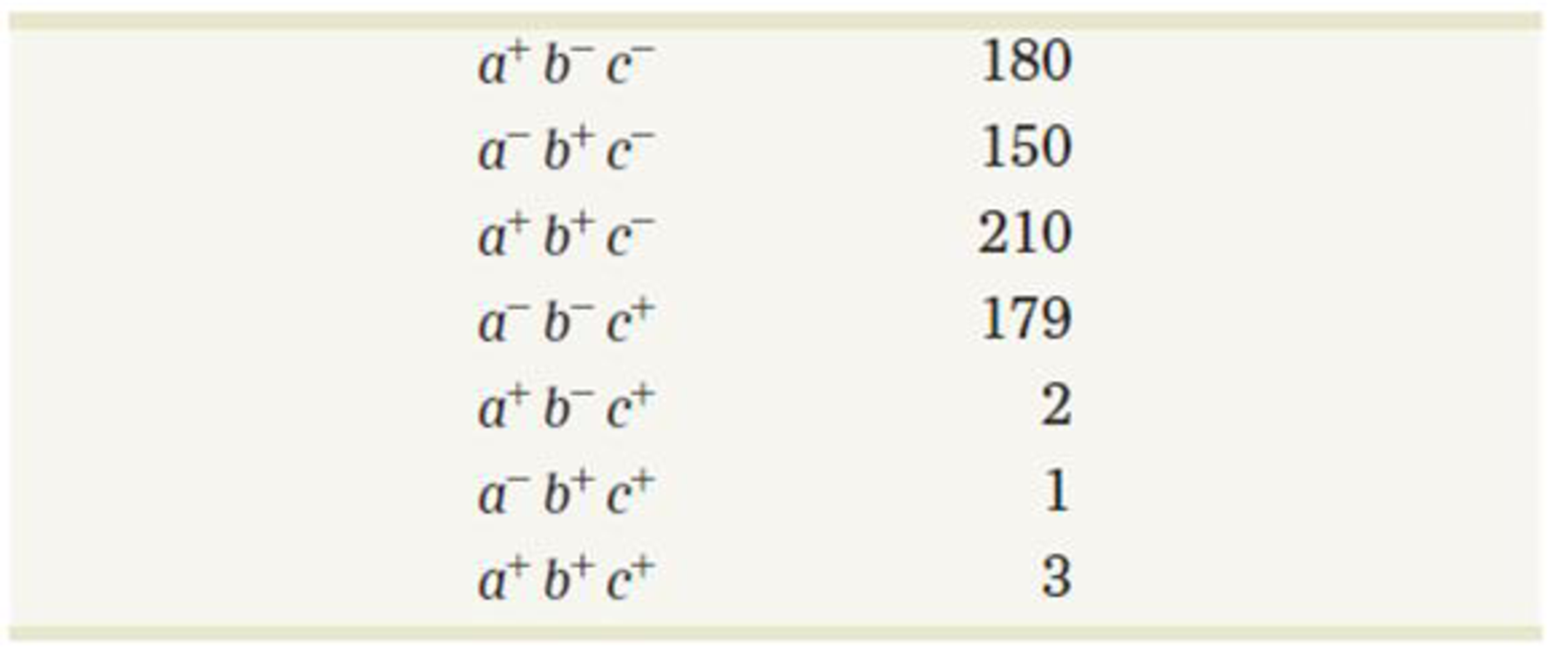
Concepts of Genetics (11th Edition)
11th Edition
ISBN: 9780321948915
Author: William S. Klug, Michael R. Cummings, Charlotte A. Spencer, Michael A. Palladino
Publisher: PEARSON
expand_more
expand_more
format_list_bulleted
Concept explainers
Textbook Question
Chapter 6, Problem 9PDQ
In a transformation experiment, donor DNA was obtained from a prototroph bacterial strain (a+b+c+), and the recipient was a triple auxotroph (a−b−c−). What general conclusions can you draw about the linkage relationships among the three genes from the following transformant classes that were recovered?

Expert Solution & Answer
Want to see the full answer?
Check out a sample textbook solution
Students have asked these similar questions
Explain in a small summary how:
What genetic information can be obtained from a Punnet square? What genetic information cannot be determined from a Punnet square?
Why might a Punnet Square be beneficial to understanding genetics/inheritance?
In a small summary write down:
Not part of a graded assignment, from a past midterm
Chapter 6 Solutions
Concepts of Genetics (11th Edition)
Ch. 6 - When the interrupted mating technique was used...Ch. 6 - In a transformation experiment involving a...Ch. 6 - In complementation studies of the rII locus of...Ch. 6 - Prob. 1CSCh. 6 - Prob. 2CSCh. 6 - Prob. 3CSCh. 6 - Prob. 4CSCh. 6 - HOW DO WE KNOW? In this chapter, we have focused...Ch. 6 - Review the Chapter Concepts list on p. 123. Many...Ch. 6 - With respect to F+ and F bacterial matings, answer...
Ch. 6 - List all major differences between (a) the F+ F...Ch. 6 - Describe the basis for chromosome mapping in the...Ch. 6 - In general, when recombination experiments are...Ch. 6 - Why are the recombinants produced from an Hfr F...Ch. 6 - Describe the origin of F bacteria and merozygotes.Ch. 6 - In a transformation experiment, donor DNA was...Ch. 6 - Describe the role of heteroduplex formation during...Ch. 6 - Explain the observations that led Zinder and...Ch. 6 - Prob. 12PDQCh. 6 - Prob. 13PDQCh. 6 - Two theoretical genetic strains of a virus (abc...Ch. 6 - The bacteriophage genome consists of many genes...Ch. 6 - If a single bacteriophage infects one E. coli cell...Ch. 6 - A phage-infected bacterial culture was subjected...Ch. 6 - In recombination studies of the rII locus in phage...Ch. 6 - In an analysis of rII mutants, complementation...Ch. 6 - If further testing of the mutations in Problem 18...Ch. 6 - Using mutants 2 and 3 from Problem 19, following...Ch. 6 - During the analysis of seven rII mutations in...Ch. 6 - In studies of recombination between mutants 1 and...Ch. 6 - Prob. 24ESPCh. 6 - An Hfr strain is used to map three genes in an...Ch. 6 - A plaque assay is performed beginning with 1 mL of...Ch. 6 - In a cotransformation experiment, using various...Ch. 6 - For the experiment in Problem 26, another gene, g,...Ch. 6 - Bacterial conjugation, mediated mainly by...Ch. 6 - A study was conducted in an attempt to determine...Ch. 6 - Prob. 31ESP
Knowledge Booster
Learn more about
Need a deep-dive on the concept behind this application? Look no further. Learn more about this topic, biology and related others by exploring similar questions and additional content below.Similar questions
- Noggin mutation: The mouse, one of the phenotypic consequences of Noggin mutationis mispatterning of the spinal cord, in the posterior region of the mouse embryo, suchthat in the hindlimb region the more ventral fates are lost, and the dorsal Pax3 domain isexpanded. (this experiment is not in the lectures).a. Hypothesis for why: What would be your hypothesis for why the ventral fatesare lost and dorsal fates expanded? Include in your answer the words notochord,BMP, SHH and either (or both of) surface ectoderm or lateral plate mesodermarrow_forwardNot part of a graded assignment, from a past midtermarrow_forwardNot part of a graded assignment, from a past midtermarrow_forward
- please helparrow_forwardWhat does the heavy dark line along collecting duct tell us about water reabsorption in this individual at this time? What does the heavy dark line along collecting duct tell us about ADH secretion in this individual at this time?arrow_forwardBiology grade 10 study guidearrow_forward
arrow_back_ios
SEE MORE QUESTIONS
arrow_forward_ios
Recommended textbooks for you
- Case Studies In Health Information ManagementBiologyISBN:9781337676908Author:SCHNERINGPublisher:Cengage
 Biology: The Dynamic Science (MindTap Course List)BiologyISBN:9781305389892Author:Peter J. Russell, Paul E. Hertz, Beverly McMillanPublisher:Cengage Learning
Biology: The Dynamic Science (MindTap Course List)BiologyISBN:9781305389892Author:Peter J. Russell, Paul E. Hertz, Beverly McMillanPublisher:Cengage Learning Biology 2eBiologyISBN:9781947172517Author:Matthew Douglas, Jung Choi, Mary Ann ClarkPublisher:OpenStax
Biology 2eBiologyISBN:9781947172517Author:Matthew Douglas, Jung Choi, Mary Ann ClarkPublisher:OpenStax  Human Heredity: Principles and Issues (MindTap Co...BiologyISBN:9781305251052Author:Michael CummingsPublisher:Cengage Learning
Human Heredity: Principles and Issues (MindTap Co...BiologyISBN:9781305251052Author:Michael CummingsPublisher:Cengage Learning Biology Today and Tomorrow without Physiology (Mi...BiologyISBN:9781305117396Author:Cecie Starr, Christine Evers, Lisa StarrPublisher:Cengage Learning
Biology Today and Tomorrow without Physiology (Mi...BiologyISBN:9781305117396Author:Cecie Starr, Christine Evers, Lisa StarrPublisher:Cengage Learning

Case Studies In Health Information Management
Biology
ISBN:9781337676908
Author:SCHNERING
Publisher:Cengage

Biology: The Dynamic Science (MindTap Course List)
Biology
ISBN:9781305389892
Author:Peter J. Russell, Paul E. Hertz, Beverly McMillan
Publisher:Cengage Learning

Biology 2e
Biology
ISBN:9781947172517
Author:Matthew Douglas, Jung Choi, Mary Ann Clark
Publisher:OpenStax

Human Heredity: Principles and Issues (MindTap Co...
Biology
ISBN:9781305251052
Author:Michael Cummings
Publisher:Cengage Learning


Biology Today and Tomorrow without Physiology (Mi...
Biology
ISBN:9781305117396
Author:Cecie Starr, Christine Evers, Lisa Starr
Publisher:Cengage Learning
Bacterial Genomics and Metagenomics; Author: Quadram Institute;https://www.youtube.com/watch?v=_6IdVTAFXoU;License: Standard youtube license